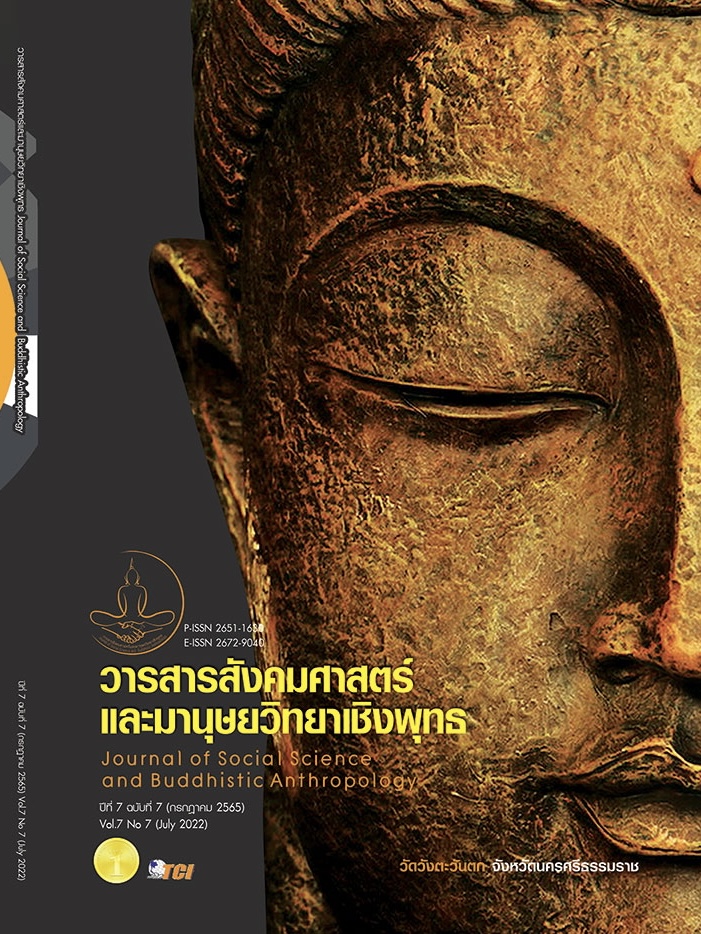FACTOR ANALYSIS OF DIGITAL TRANSFORMATION LITERACY FOR TEACHERS IN SECONDARY SCHOOLS UNDER THE OFFICE OF THE BASIC EDUCATION COMMISSION
Keywords:
Factors Analysis, Digital Transformation Literacy, Digital age teacherAbstract
The Objectives of this research article were to analyze the factors analysis Digital transformation of teachers in secondary schools under the Office of the Basic Education Commission. The researcher used a quantitative research methodology. Research tools The researcher extracted the teachers' digital transformation literacy variables of teachers in secondary schools. The variables obtained from the synthesis were used to create a screening form for 7 qualified variables. Able to pass the screening test for 36 variables. Create a Rating scale questionnaire divided into 2 parts : Part 1 is a questionnaire about general information of teachers with a checklist style and Part 2 is a questionnaire on the digital transformation awareness of teachers in secondary schools. They were Likert type with a the reliability of 0.975. The sample group used in this research teacher in secondary school. The sample size using the concept of Hair et al. ratio of variables to sample size 1:20 of 720 people by stratified random sampling analyze data Analysis of the digital transformation literacy component of teachers in secondary schools. The correlation coefficient between the variables was examined using statistics Kaiser-Meter-Olkin (KMO) and Bartlett’s test of sphericity got .952. Determine the suitability of the correlation merix between the correlated and appropriate variables. The results showed that the analysis of the digital transformation literacy factor of teachers in secondary schools consisted of 4 factors 1) Security in accessing digital media 2) Technology and work 3) Technology application and 4) Equal knowledge of changes with digital.
References
กัลยา วานิชย์บัญชา. (2551). การวิเคราะห์สถิติขั้นสูงด้วย SPSS for windows. (พิมพ์ครั้งที่ 5). กรุงเทพมหานคร: จุฬาลงกรณ์มหาวิทยาลัย.
ฉัตรพงศ์ ชูแสงนิล. (2564). การใช้เทคโนโลยีอย่างรู้เท่าทัน. เรียกใช้เมื่อ 2 ตุลาคม 2564 จาก https://www.scimath.org/article-technology/item/11534-2020-05-01-03-32-41
ฐิติวัสส์ สุขป้อม และคณะ. (2563). ครูกับเทคโนโลยีการสอนในศตวรรษที่ 21. วารสารบัณฑิตวิทยาลัย มหาวิทยาลัยราชภัฏจันทรเกษม, 15(2), 1-16.
บัณฑิต เอื้ออาภรณ์. (2562). จี้มหา"ลัยปรับตัวก่อนที่จะล่มสลาย.เดลินิวส์ออนไลน์. สืบค้นเมื่อ. เรียกใช้เมื่อ 30 ตุลาคม 2564 จาก https://www.dailynews.co.th/education /700971
ยุทธ ไกยวรรณ์. (2556). การวิเคราะห์สถิติหลายตัวแปรสำหรับงานวิจัย = Multivaraite statistical analysis for research. กรุงเทพมหานคร: จุฬาลงกรณ์มหาวิทยาลัย.
สมใจ เดชบำรุง. (2561). คุณลักษณะของครูไทยในศตวรรษที่ 21. วารสารศึกษาศาสตร์ มหาวิทยาลัยศิลปากร, 16(1), 120-131.
สำนักงานคณะกรรมการการศึกษาแห่งชาติ. (2545). พระราชบัญญัติการศึกษาแห่งชาติ พ.ศ. 2542 และที่แก้ไขเพิ่มเติม (ฉบับที่ 2) พ.ศ. 2545. กรุงเทพมหานคร: บริษัท พริกหวานกราฟฟิค จำกัด.
สำนักงานคณะกรรมการข้าราชการพลเรือน. (2564). โครงการพัฒนาทักษะความเข้าใจและใช้เทคโนโลยีดิจิทัลของข้าราชการและบุคลากรภาครัฐ. เรียกใช้เมื่อ 2 ตุลาคม 2564 จาก https://www.ocsc.go.th/DLProject/mean-dlp
สำนักงานเลขาธิการสภาการศึกษา. (2562). แนวปฏิบัติของการสร้างและส่งเสริมการรู้ดิจิทัลสำหรับครู. กรุงเทพมหานคร: บริษัท พริกหวานกราฟฟิค จำกัด.
สุชัชวีร์ สุวรรณสวัสดิ์. (2561). ปี’62 มหา’ลัยต้องปรับตัวแบบหักศอกลดวิชาบังคับเพิ่มวิชาเลือกให้นักศึกษามีอิสระในการเรียนรู้. มติชนออนไลน์. เรียกใช้เมื่อ 2 ตุลาคม 2564 จาก https://www.matichon.co.th/education/news_1294950
สุชาติ ประสิทธิ์รัฐสินธุ์. (2556). การใช้สถิติในการวิจัยอย่างถูกต้องและได้มาตรฐานสากล = Applications ofstatistical methodes in research (พิมพ์ครั้งที่ 6). กรุงเทพมหานคร: สามลดา.
Bower B. L. (2001). Distance education: Facing the faculty challenge. Online Journal of Distance. Learning Administration, 4(2), 1-6.
Candy, P.C. (2022). Lifelong learning and information literacy. White Paper preparedfor UNESCO. Lifelong learning and information literacy. Retrieved October 20, 2021, from https://www.nclis.gov/libinter/ infolitconf & meet/candy-paper.html
Curran, D. (2018). Risk, innovation, and democracy in the digital economy. European Journalof Social Theory, 21(2), 207-226.
Federico, B. et al. (2020). Digital transformation challenges: strategies emerging from a multi-stakeholder approach. The TQM Journal, 32(4), 697-724.
Hair, J. et al. (2010). Multivariate Data Analysis (7th ed.). New Jersey: Pearson Prentice Hall.
Keengwe J. & Kidd T. T. (2010). Towards best practices in online learning and teaching in higher. Education. MERLOT JOnline Learn. Teach, 6(2), 533-541.
Malisuwan, S. (2016). Analysis of roadmaps and trends for mobile communication technologyin Thailand. International Journal of Advanced Research in Engineering and Technology, 7(1), 68-79.
Pahae, S. (2017). The Paradigm of Educational Technology in the Digital Age. Phare, Thailand: Phare Thai Utsahakarnpim.
Rajhans, V. U. et al. (2020). Impact of COVID-19 on academic activities and way forward in IndianOptometry. Journal of Optometry, 13(4), 216-226.
Rapanta, C. et al. (2011). Balancing Technology, Pedagogy and the New Normal: Post-pandemicChallenges for Higher Education. Postdigital Science and Education , 3(2021), 715-
Xie, J. & Rice, M. F. (2021). Instructional designers’ roles in emergency remote teaching during. Distance Education, 42(1), 70-87.
Downloads
Published
How to Cite
Issue
Section
License
Copyright (c) 2022 Journal of Social Science and Buddhistic Anthropology

This work is licensed under a Creative Commons Attribution-NonCommercial-NoDerivatives 4.0 International License.








